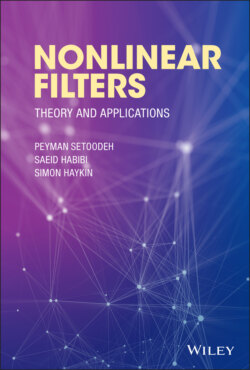Читать книгу Nonlinear Filters - Simon Haykin - Страница 28
2.6.3 Discretization of Nonlinear Systems
ОглавлениеUnlike linear systems, there is not a general functional representation for discrete‐time equivalents of continuous‐time nonlinear systems. One approach is to find a discrete‐time equivalent for the perturbed state‐space model of the nonlinear system under study [19]. In this approach, first, we need to linearize the nonlinear system in (2.61) and (2.62) about nominal values of state and input vectors, denoted by and , respectively. The perturbation terms, denoted by , , and , are defined as the difference between the actual and the nominal values of state, input, and output vectors, respectively:
(2.85)
(2.86)
(2.87)
Since input is usually derived from a feedback control law, it may be a function of the state, . In such cases, a difference between the actual and the nominal values of the state (a perturbation in the state) leads to a difference between the actual and the nominal values of the input (a perturbation in the input), and in effect therefore, . Otherwise, can be zero. Using the Taylor series expansion and neglecting the higher‐order terms, we obtain the following perturbation state‐space model:
(2.88)
(2.89)
where and , respectively, denote the Jacobian matrices obtained by taking the derivatives of with respect to and . Similarly, and are Jacobians of with respect to and .
Now, the continuous‐time state‐space model in (2.88) and (2.89) can be treated as an LTV system. The discrete‐time equivalent of (2.88) and (2.89) is obtained as:
(2.90)
(2.91)
where is the solution to
(2.92)
with the initial condition:
(2.93)
when we set and . As before, is given by:
(2.94)
So far, this chapter has been focused on studying the observability of deterministic systems. Section 2.7 discusses the observability of stochastic systems.
